
The Beginnings of Track-Racing
The Track-Racing Era and the Alban Adams Myth.
The Diesel Car Racing Era:
Our First Slot Racing Track in 1947
It was early in 1947 that Henri realised that round-the-pole was going to be a very limited way of racing with the only form of competition was racing one car at a time against the stop-watch. One day, during that year, while I was still at school, he gave me my first lesson in panel-beating mild-steel sheet. I had to help beat out and build an oval banked track. It was constructed of 22 swg. flat steel sheet to form the following cross-section.

It had two semi-circular, banked end-curves with two straights joining the bends. One of the straights had an under-and-over cross-over section so that races would be fair as the inside car on one lap would be on the outside on the next. It was for two cars powered by prototype BMP 0.9 cc. diesel engines, as the track was too small to take cars powered by the 3.5cc. BMP engines which were the only ones that we were making and in production at the time. As the track was beaten out of steel sheet it had to be under cover so we built it around the workshop, so it was about 16 feet by 30 feet in all. It had to run under the workbenches, so the cars would disappear at times, as would a model locomotive in a tunnel. The cars would race at about 40 mph, and the heavy, nostalgic smell of fuel and Castrol Oil was overpowering. We had a friendly chemist at that time and so we used to mix our own fuels with all sorts of additives such as amyl-nitrite (which came in small glass phials for use as a heart stimulant, which I used to break open and add to the mixture. This type of racing was a very exciting experience and took model-car racing into a new era. The cars had bogeys underneath steering the front axle, and were under-hung to stop the cars leaving the track. The rear bogey had vertical rollers, which ran in the slot to allow the tail of the car to slide and swing. However, this was only a prototype and more were to be developed from those early efforts. It was the first time that this idea had been put into practice in the world as far as we knew, and I don't give a damn if we were not first ever, but we were the pioneers that developed it into a fascinating and very commercial hobby.
As far as the invention and creative talent behind most of rail and slot-racing was concerned in the early days after WW2, it was achieved by the Baigent family at the Beverley Gardens' workshop, built in our garden, with the participation and encouragement of very close and trusted friends. Thanks to all of them that contributed.
One of those was Alan Arnold, does anybody know where is? He would be in his 70s? He went across the 'pond' to Canada then on to the USA, at Lockheed I think? He was one of the best aeromodellers that I had the good fortune to know, he was so very talented, and we were very lucky to have him and his wife, Fran, as friends. He designed the tail-less powered Kiel Kraft 'Pteradacyl' which he flew so very well. Among the other visitors were members of the Bournemouth Model Club and the Westbourne Model Club et al. Members like dear old Eddie Hanks (sadly killed my a motorist who was turning right without signaling when Eddie was overtaking on his motorcycle; he died too young), Phil Smith of Veron Aircraft, Gerry Buck of the Meteor Club in Staffordshire, 'Bob' Curwen of the Raildromers, Captain Grant and his son, 'Digger', of Grant models, Col. C E Bowden. Also, R. R. C. (Robb) Walker. A Naval Commander (who taught me trigonometry) whose name I can't remember, Cyril Heath (who taught me graduate electronics, are you still around, Cyril?), The Late Bob Wheatley, Joe Kenworthy (Wakefield Trophy 1933), Bill Gilbert, C A (Rip) Rippon of Ripmax, Lord McAlpine, Peter Hampton (ex-Tempest pilot, of Hampton's the Estate Agents and Auctioneers), the late Michael Flew (long-time friend, and really fine modeller and expert at electronics who I went through college with), Pete Cock (winner of the Control-line (U-control) stunt Gold Cup 1949 at Ilford with our ERE 2.5 cc diesel motor and a stack of my own special ultra-thin propellers, which I would stay up late into the night to hand-carve! The blades were translucent on the outer halves, one could almost see through them, but of course, they were easily damaged on landing. We had to set the engines to stop with the blade horizontal as there were no undercarriages. Generally we advised starting with an electric motor with a rubber cup on the spinner. After receiving deep injuries on our starting fingers we found a way of starting by flicking the leading edge of the propeller against compression and it would fire back and start in the right direction. I still carry the scars! We set up a thrust-measuring device to achieve the best propeller forms. It was simple, and a great help. It was just a radial arm mounted on ball-races with a sprung load, which we calibrated.
Many 'chips' changed hands on the outcome of those slot-races! I was not allowed to bet because I would start the cars, and so I was deemed to be able to fiddle the outcome! Now, would I have done that?! It was such a marvelous time. We were choosy about who saw the project but most of the model-aero club members saw it running, and much laughter and cheering was heard from the workshop.
In the Bournemouth Echo in the late 1940s this cutting appeared, the correspondent must have been aware of our early track. I have copied part of another page about the early years for the benefits of enthusiasts that missed out on the first developments of the hobby of track-racing.
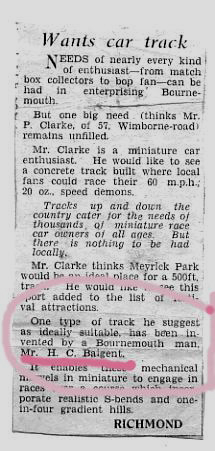
Early 1948, Henri changed the attachment system to a mono-rail in the form of a 5/16in, sometimes a 1/4in, rod supported on thin pillars. Quite a few tracks like this were made under his guidance by enthusiastic model-clubs, as far away as Guernsey and a particularly successful track at the Meteor Club in the Five Towns fronted by a delightful gentleman called Gerry Buck, who used to call on us frequently. Also Bob Curwen called often, he was from the Raildromers Club, and was the chairman of the MCA for its inaugural year. Bob is shown elsewhere on this site with one of his round-the-pole racers. Both of these enthusiasts were perfect gentlemen, but very competitive. Henri was always ready and willing to enjoy a chat with modellers and share his experiences and latest ideas with them. Quite the opposite of what history has laid at his door in some comments on some forums. If anything, he was too trusting and would share his experiences with most other modellers. It was to be his downfall later.
One of the tracks was laid on wood-block floor in a church hall with the kind permission of the incumbent. This was in the Pottery District of England, in the Stoke-on-Trent area. By this time the cars were powered by a 2.5cc diesel engine, some of which Henri and I had developed and adapted for the purpose of round-the-pole racing. These cars were 1/12th scale and they would reach more than 60 mph, absolute beasts! The smell and the noise were incredible. The likes of this racing will never be seen again, more is the pity.
One of Henri's champions was D J Laidlaw Dickson who would come and visit us to find a story for his magazine articles. He was another real gentleman who tried be generous and equitable in his handing out praise for the efforts he saw modellers make. I have seen his book 'Model Car Rail Racing' offered for US $180 on the Internet so as it is not generally available to many, so I hope that his family, or his publishers, will permit me to include some extracts from this marvelous book for today's enthusiasts to see.

above, an excerpt from Laidlaw-Dicksons 'Model Car Rail Racing' book chapter XI

above, an excerpt from the text on pp 101/3 of Laidlaw-Dickson's book. I am afraid that it is not correct. This system of racing was patented by Henri before he met Alf Walshaw or Alban Adams. The company was called Henri Baigent Ltd when first formed, not as stated. Model Road Racing Cars Ltd was formed after Adams seized control, see text
above, the article that appeared in Model Motor Magazine February 1951, before MRRC Ltd was formed, click on the image of each page to read the texts
The patents for rail-racing, were applied for, under the auspices of Hughes and Young, on 8 May 1950 and were held by Henri. I still have them today. Patent No.11452/50 "Improvements in or relating to model vehicles and guide rails therefore" was applied for by Yvonne Murray and Henry Cyril Baigent. I don't remember who Yvonne was, but I think she must have been a lawyer friend who help pay for the application.
As a matter of interest, I found this in an Google search under Henri Baigent. It refers to the Baigent case as applied in case law in Australia:
Henri Baigent Ltd's Application 1953 RPC 441:
"In the Baigent case the honorary secretary of a model car association, on behalf of the association, opposed a patent application which claimed model vehicles and the tracks on which they ran. The association organised meetings for running model cars and provided the track on which the cars ran. The public were charged for admission to the meetings and the association's finances depended to a large extent on these charges. The Assistant Comptroller decided the association had sufficient interest because the association's activities could be regarded as trading in the tracks on which the model cars ran."
I want to make it very clear that Henri had nothing whatever to do with this sad affair, by this time Henri was not involved with the company that used his name. He was on very friendly terms with the Association and was always generous in giving his ideas to the members. It was Alban Adams who prosecuted the case against themodel clubs.
I was called up by the Royal Air Force in November 1949 so Henri had to manage on his own but he just worked even longer hours to make up for the loss of his assistant. While I was away on squadron duties much had happened. Henri had become friendly with Alf Walshaw, a local modeling acquaintance who ran the little Post Office in Lytchett Minster, near Poole, Dorset. Henri could not cope with all the orders on his own, so when Alf offered some help, Henri was glad of assistance with making the tyres etc. In my absence Walshaw wanted to put up some funds to buy some extra equipment and to put on shows. In 1951,he persuaded Henri to form a company together called Henri Baigent Ltd. and it was agreed that Henri would bring his name and reputation. The funds were insubstantial but they helped pay the rent for a larger workshop at Hurn Airport, today called Bournemouth Airport, in Dorset. I was made a director with shares of £10. This does not look much today, but it was very acceptable, and I was expected to be demobbed from The Royal Air Force and be active from November 1951.
The great test pilot, Brian Trubshaw, was a hero of mine, and was a regular enthusiastic visitor to the Hurn Workshops when he was not testing aircraft, and he would bring several chums to bet on the outcome of a race sometimes, and the loser, no doubt, had to buy the drinks. Various other model and toy manufacturers were taking a lot of interest in the system, while the press were very interested and keen to publish any news.
above, a cutting from the Bournemouth Daily Echo early 1951
The Model Engineer Exhibition at The New Horticultural Hall, Westminster.
August 22nd 1951 was a very big date in our lives when we were invited by Model Maker Magazine to exhibit at the Model Engineer Exhibition at The New Horticultural Hall, Westminster. The track was quite a large figure 8 and took up all the dais at the end of the hall except for the space for the onlookers. I was still in the Royal Air Force but my Commanding Officer allowed me to take special leave from my duties at the squadron for the whole of the show schedule. It was clear that he was quite excited and intrigued, and was certainly generous and understanding. The track was mostly built by Alf Walshaw and Henri, while Henri and I made the cars.
The Exhibition was a great success and our track was the main attraction. Sometimes the visitors overflowed all the available space on the dais, and pushed forward to get a closer view. The national press, BBC Television and cinema film-crews were interviewing and filming the proceedings, partlicularly when some famous Grand Prix racing-drivers coming along. There was Stirling Moss, Bob Gerard, Reg Parnell and Mike Hawthorn. Raymond Baxter of the BBC was commentating on the featured races. The latter made me feel less nervous before the TV and Pathe news filming and warned me of some of the pit-falls and some of the tricks of the press. He was an absolute gentleman and I still treasure this letter that I received from him afterwards.
click to enlarge
click to enlarge
The crowds on the dais were overflowing onto the main floor for most of the exhibition. The track was the main attraction due to the smell and noise of the six diesel engines screaming their little hearts out. We had a fleet of six cars and quite a lot of spares including whole Mills 0.75 cc engines as the show would be very demanding, to cover breakdowns. We wore out all the engines during the first week and it was decided that I would return home and spend the weekend rebuilding all the engines and refurbishing all the models, with Henri's help, of course! As the track had three lanes, we expected to be able to keep the show 'on the road' alright, but it was a close call. We needed all the kit that we took. Alf Walshaw was officially in charge of the track as he knew how it had been assembled and he had expected problems during assembly. I was in charge of the cars, but we shared the task as a good team always does. The first week was particularly tough on the cars and we had some serious problems with wear and tear, so something drastic had to be done. Walshaw decided to stay behind in our little hotel room in Cricklewood to rest while I had to take home a batch of cars to rebuild them. I did not get any sleep except on the train on Saturday evening until I returned to Waterloo on the London train very early hours of Monday morning. All was well for opening on that day, but it was a tremendous rush and I was glad that I was only just twenty years old. Henri just expected me to do whatever was needed, but he applied the same rules to himself. He was sometimes hard on others, but he was always hard on himself!


above, left to right, Maserati, Alfa Romeo, BRM, Ferrari: above right, 6 cars ready for the ME Exhibition in London, note, these cars were put together to be reliable and durable and no attempt was made to make them true to scale but good enough to make it obvious what they represented during a race.

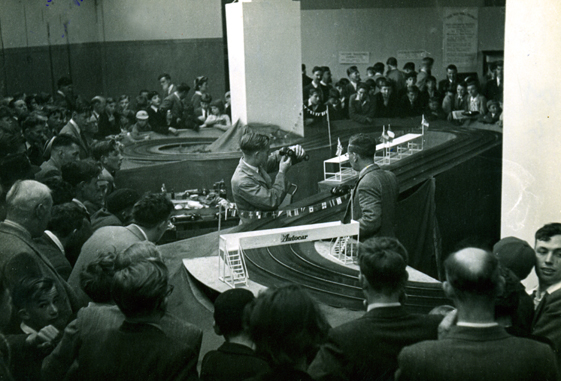
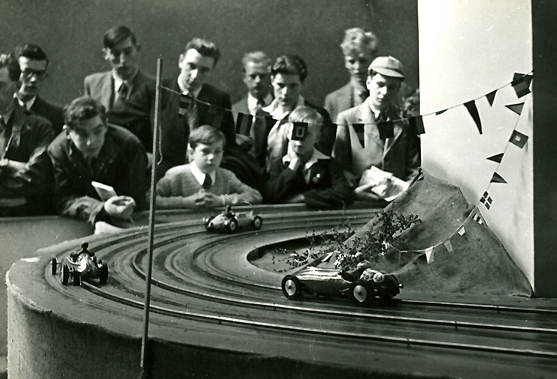
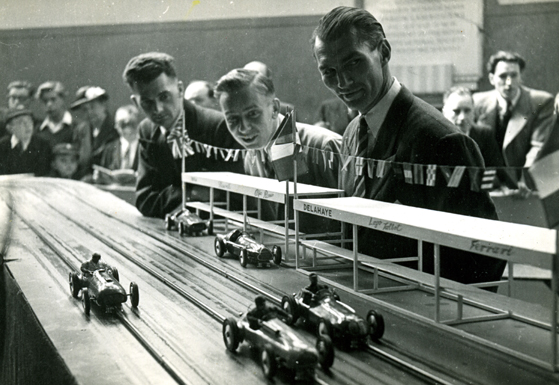
above, pictures of the Model Engineer Exhibition, New Exhibition Hall, Westminster, London including Alf Walshaw and myself with Gerry Buck in two shots...did I really have hair then?!!! Anybody recognise yourselves in the audience? If anybody remembers this show, I would be pleased to hear from you.
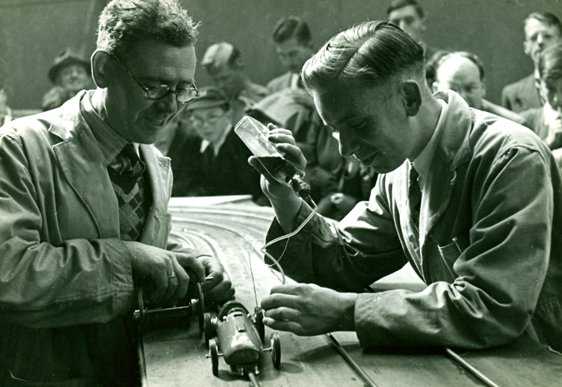
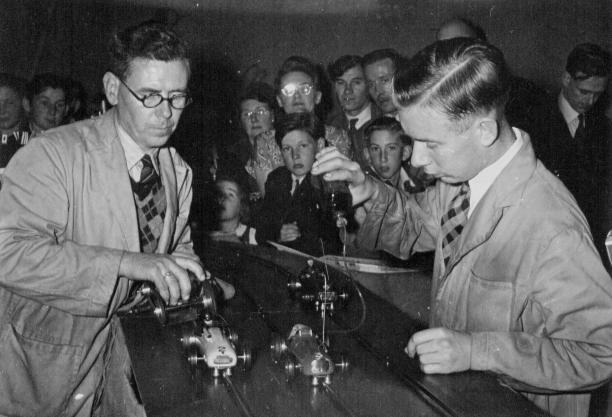
Alf Walshaw and myself preparing cars for a run at the Model Engineer Exhibition.
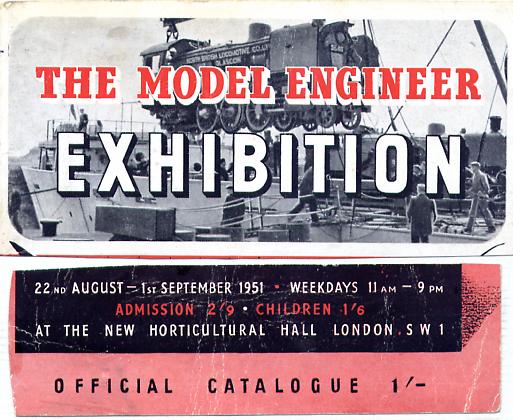

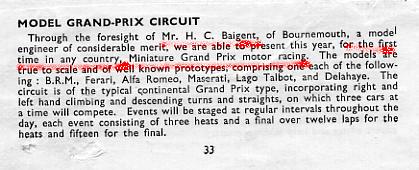
Copy of parts of the program for the 1951 Model Engineer Exhibition, London
above , cuttings from The Daily Express, the Daily Herald, and The Daily Express again, and, right, the Daily Graphic, click on images for readable images
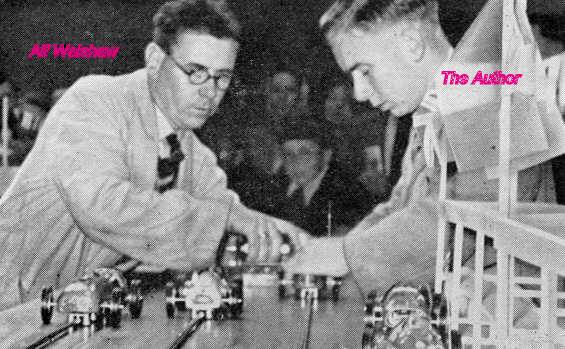
above, a picture of Alf Walshaw and my youthful self on the right
I would beg to differ with the actual caption. Alf, actually looked after my welfare, in an avuncular way, which he did very well and arranged accommodation for us in a dingy little room in Cricklewood! I had to repair the cars he maladjusted at times, sometimes working between races, during breaks in the displays, and late into the evening. Alf was an average model engineer and took most of his ideas from my very generous and too-trusting father. I am fairly sure that this was one of Henri's main weakness and contributed to his losses. However, Alf was always amenable and pacific in character and there was a lot I liked about him. He was more nervous than me when we were displaying the track, but to be fair, I was young and enthusiastic and oblivious to the possibilities of failure to perform with the consequences for our company's reputation.
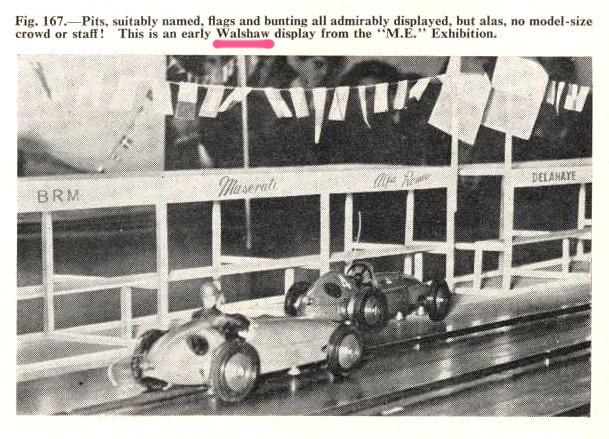
You may already have recognised this as a Baigent (not a Walshaw) display at the Model Engineer exhibition August 1951, frankly we were invited to put on a major event with very little lead-time. Sadly there was no time for more than a minimal scenery. We would have loved to have had more!
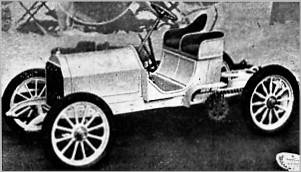
Also, for general interest, I have included this magnificent chain-driven Mercedes by Major T W 'John' Stubbs.
This beautiful model was exhibited on the Army stand. Sadly, it was not entered in the competition section of the Exhibition but it would have won a medal according to the experts at the time, if it had been. John was a really excellent modeller, and a good friend of Henri's and much admired Henri's work. He wrote to me after Henri died, in 1972, and maintained that Henri had taught him most of what he knew about modeling. I think that was over magnanimous, but was a pleasing tribute. I mislaid the letter before I had the chance to reply, sorry John, if you are still alive and kicking, will you contact me by e-mail or something.
I never did see the exhibition on the television broadcast or on the cinema screen in Pathe News as we did not have TV and I was on duty when it was screened on the cinema, but I did get ribbed afterwards, eg. 'What is it like being a film star?' However, I was bought a few drinks on the strength of it!
Following in the wake of this success many inquiries and orders came in. Our activities were getting very exciting, and everything looked 'rosy', but we needed more capital. Sadly, there was trouble ahead.......
I want to make a statement here to correct a particular misunderstanding. There was a dispute over the use of similar attachments to those patented by Henri that was reported in the press. The Model Car Association were against the 'patentees' collecting a 'licence fee' for clubs to use the patented rail-attachments. This was nothing to do with Henri. At no time did Henri get involved with this, except to write to the press and say so. By this time he had nothing to do with the evolving MRRC company which had replaced Henri Baigent Ltd. It was entirely down to Alban Adams, who plainly had no claim or right to charge anything, as he did not own the patents. It was all bluff by Adams, but it worked. Henri was always too ready, in my opinion, to share his ideas and achievements with all most modeling friends and acquaintances, including Alf Walshaw, and of course, Alban Adams.
below, more from Laidlaw-Dickson's book, giving details of the rails and the attachments used and details of Henri's simple clutch which I have included for any aspiring modellers who want to build a vintage style track..
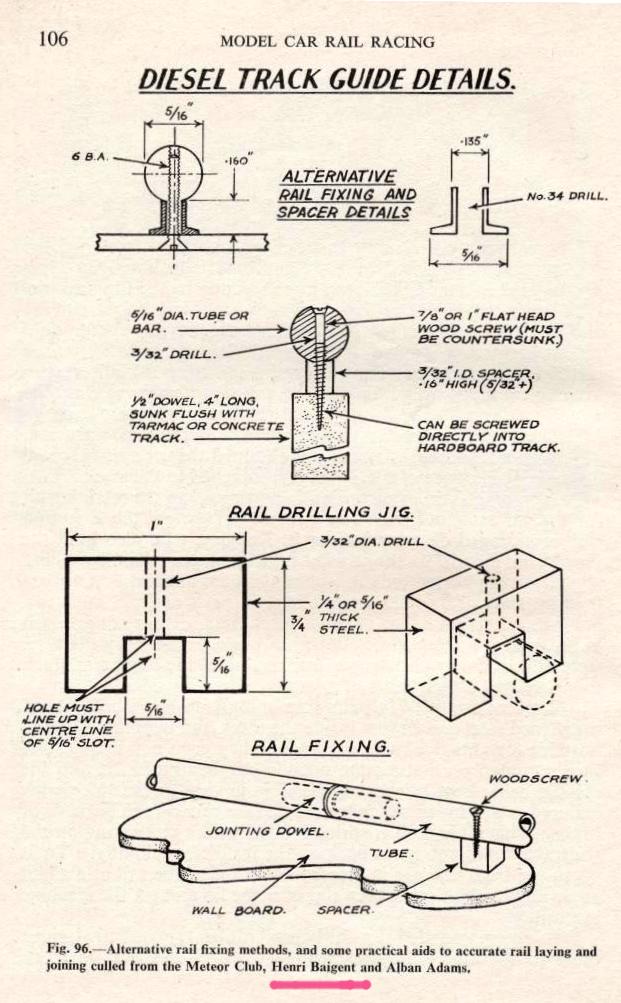
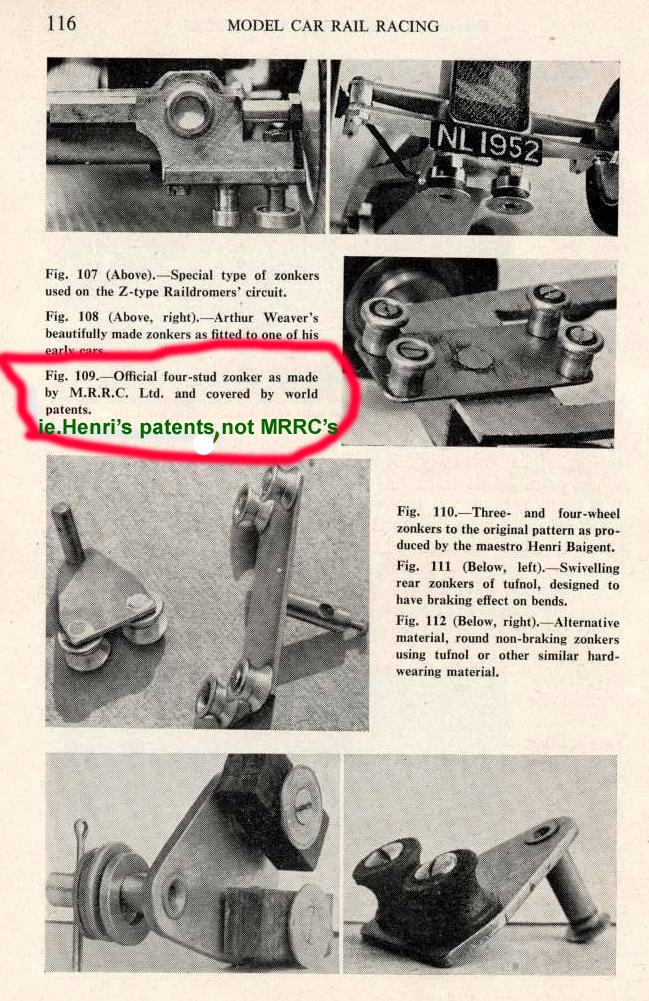

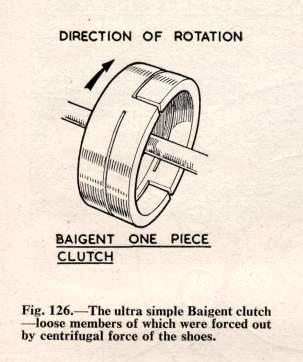

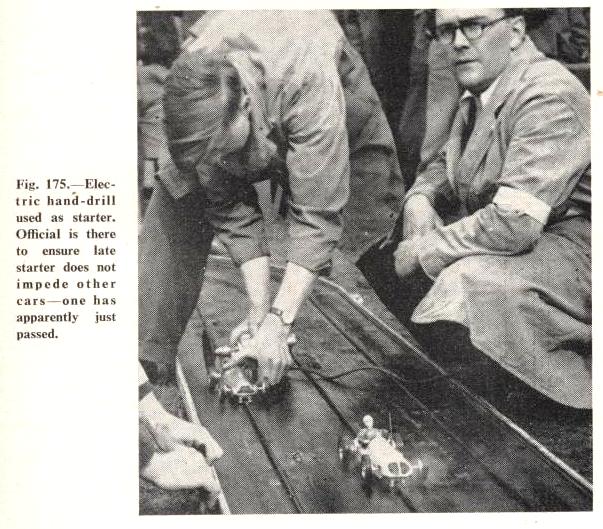
Myself, on the left of the Marshall, starting a tired, worn and reluctant Mills engine in a Lago-Talbot while the Maserati 4CL jumps ahead, just as in the full-sized cars of their time. From page 167 of Laidlaw-Dickson's book.
During the following period he moved on to look at electric propulsion with the home consumer in mind as an alternative to model railways.
Henri's Development of Electric Slot Track-Racing:
Henri managed to rent a decent workshop in another part of town and decided to develop rail tracks for electric-powered cars of a much smaller scale and then on to our first idea again of slots, not rails. As far as I can ascertain, this was the first of such tracks, in Britain, at least. The magazine, Model Maker, featured the system on the front cover of the Christmas Edition 1955 with a three page article inside.
Model Maker December 55 published this comprehensive article after the prototype was thoroughly tested in the workshop at Southbourne. Click images to read:
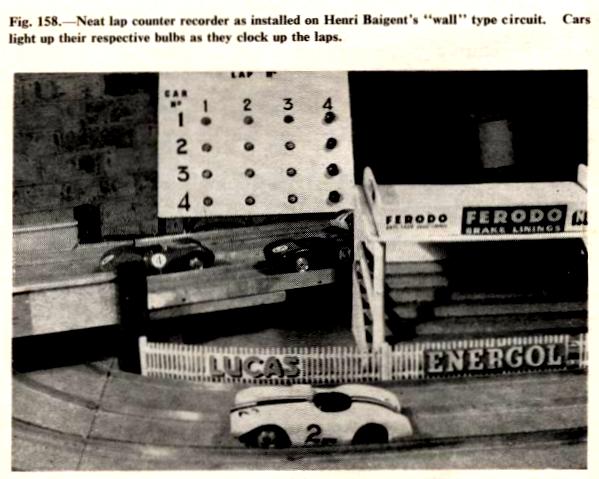
above, a photo of the track Henri's Southbourne workshop reproduced in Laidlaw Dicksons book.
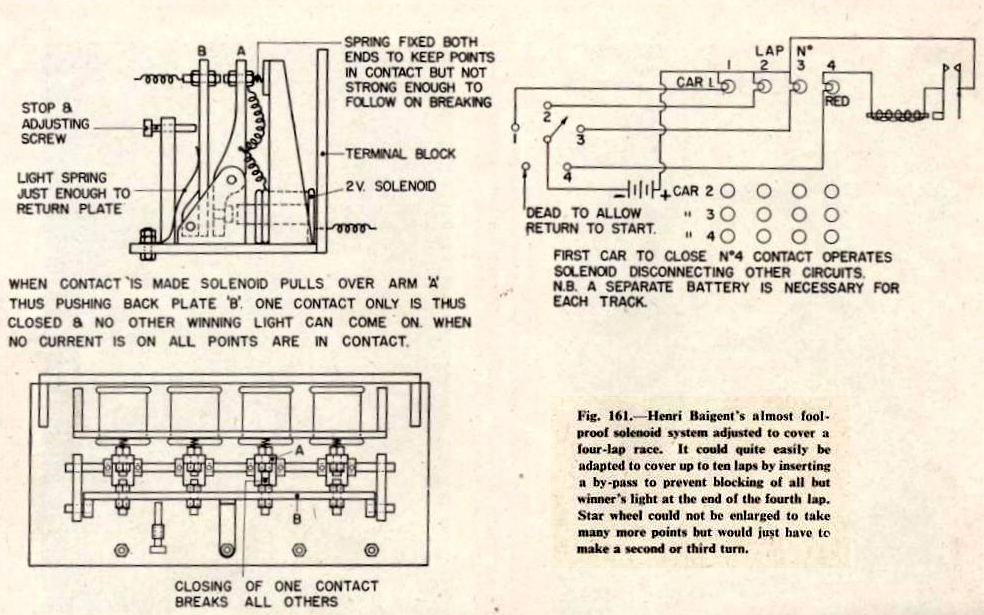



below, another excerpt from Laidlaw-Dicksons book ch IV pages 32 to34:

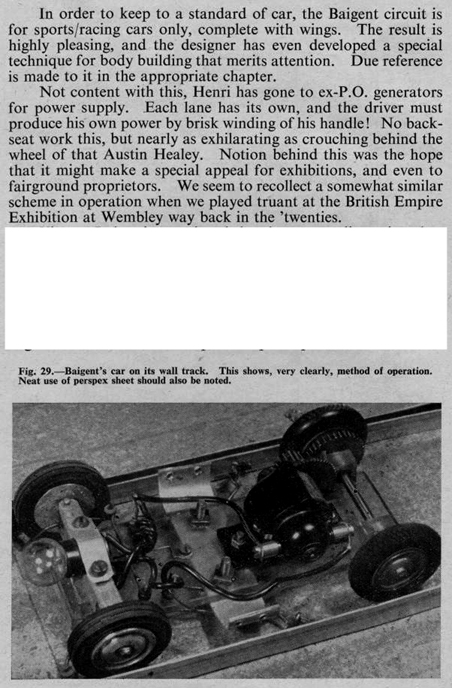
followed by a full drawing of the chassis used for the system:
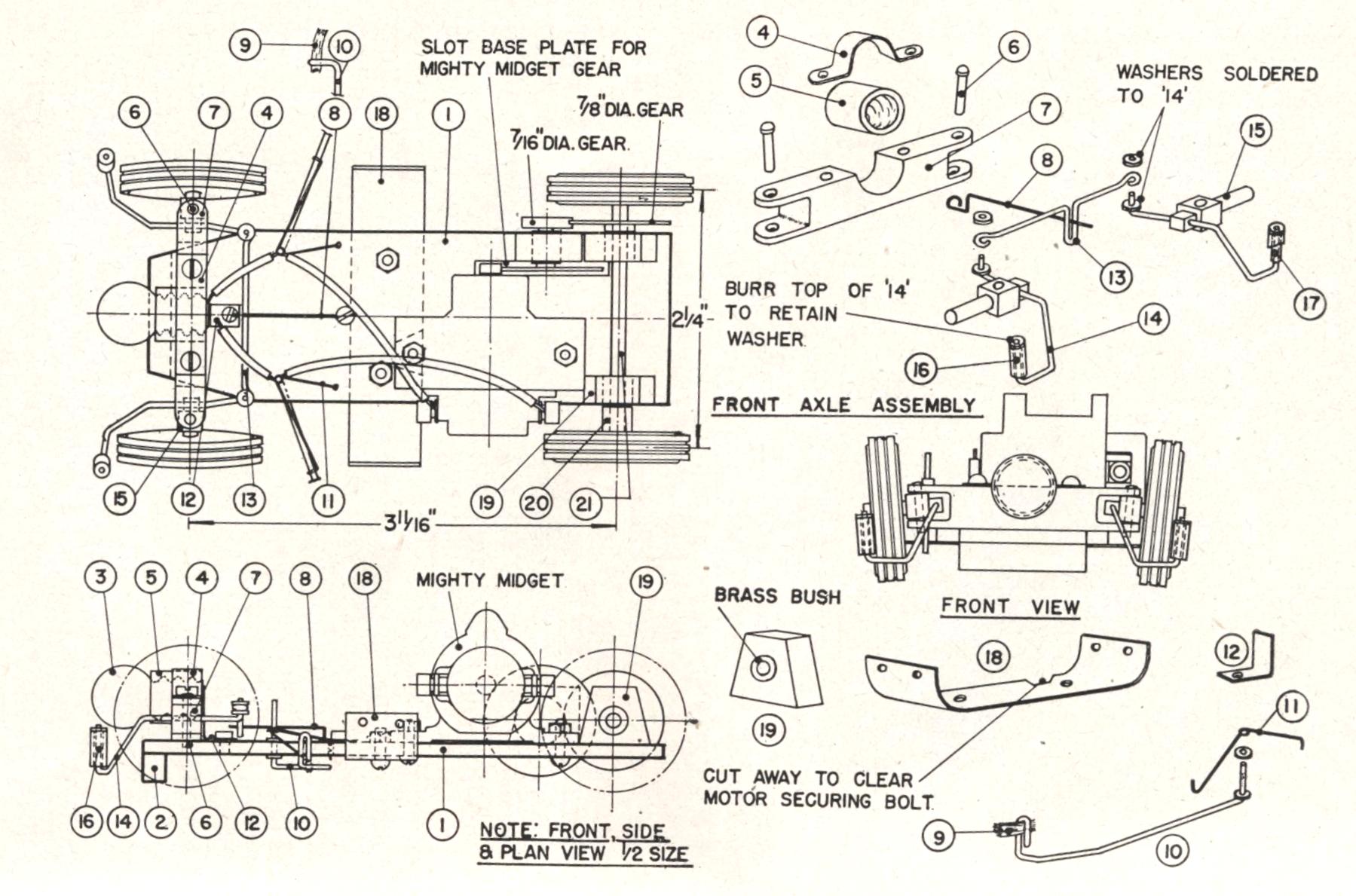

and the next page to complete the extract:
Eventually, Henri's cash flow was so dire that the master and his wife, with my sister, had to move into the wooden workshop in Southbourne, Bournemouth. From then onward, this was where Henri did his metal casting, machining, rubber-moulding, and panel beating during the day, while the ladies of the family slept there at night with very little privacy or comfort. It was particularly difficult for my sister, Muriel, as she was a young woman of about seventeen. She was very unhappy with the arrangement. I had managed to find a room in a bed-and-breakfast house locally so I was more fortunate. I managed to find some time to help Henri service some small engineering contracts for larger companies, but they were very slow at paying their bills, and still are, if they can get away with it. When visiting one day, my Uncle Keith (Henri's younger brother) made it clear to me I should carve out my own career in engineering. I was in awe of my uncle, who was the Chief Designer, and a director of R. H. Windsor Ltd. who made plastic injection moulding machines. He had a string of patents to his name. It seems ironic now that Keith was in the international fore-front in the design and development of injection moulding which would eventually lead to the production of kits that would enable modellers to produce model cars with almost as much detail as those made in metals by Henri. Of course, they are a completely different 'kettle-of-fish' to those made in the same materials as the full-sized cars. Never-the-less, they do look very good in a glass case and give the less wealthy enthusiasts a chance to enjoy and celebrate the original cars. if you ever had the privilege to pick up one of Henri's models or similar you would immediately know what I mean. Should you be interested in Keith's patents you should go here: http://v3.espacenet.com/results?sf=q&DB=EPODOC&IA=baigent&PGS=10&CY=ep&LG=en&ST=quick where you will find 14 of Keith's patents; 3 of Henri's and 1 of Henri's oldest brother, Eric, who specialised in optical apparatus and lenses.
Eventually, cash started to flow for Henri, so he was able to put his mind to new inventions and designs and find accommodation in some rooms in a large house in Bournemouth after several moves into temporary accommodation.
While settled there, he accepted a 1931 Rolls-Royce Hooper saloon as a part-payment for model cars for Rob Walker. The Rolls was a 'runner', quite a good one, but the little-ends were worn and he could not afford to get it refurbished so he decided to do it himself. He overhauled the engine and refurbished the bodywork and coach-painted it two-toned black and cream see full-size cars.
Work was a bit irregular, which meant that he was still struggling financially, so family and friends were persuading him to take an offer of work. A millionaire acquaintance, Bill Knott, manufacturer and owner of Bluebird Caravans asked him to work for him. Eventually he agreed to do so. We all felt relieved at the decision, but also felt guilty, because we knew his heart was in his cars. Bluebird was the leading make of caravans at that time and Bill wanted Henri to develop new methods of manufacture to save costs and to improve the designs. To stop the flat body-panels drumming and panting, Henri suggested swaging and ribbing the side panels. He set to designing and making a rolling machine single-handed and the ribbing became a regular feature of most future caravans. One of Bluebirds' London show-models came off Its hitch on the way over Staines Bridge and finished in the River Thames, so Bill asked Henri to design a ball and hitch that would be more secure and easy to unlatch by hand. Henri passed this on to me and I produced the design for a hitch which became the almost universal system used by most manufacturers for many a year. I was paid the handsome sum of £5 for my efforts (about 2 day's pay at that time) but what Henri was paid was another matter! Bill was very pleased and asked me to design an 80 foot mast for his amateur radio system, on which he was so keen. I did this and it was a success and received another £5! No wonder he was a millionaire. This hitch became the industry standard for many years.
It was only natural that Henri spent most of his spare time doing some more modeling. When demands started to arrive too fast for him to go to work he gave up the employment, and worked on his own again with all the uncertainty of an artist's future. His wife and family were not happy with the decision, but he was in his true element again.
He bought a Jaguar Mark 1 Special saloon from Rob Walker similar to the car in which Mike Hawthorn was killed in a road accident. It was in excellent condition, but cheap because it was an automatic. This was a joy to drive compared to the Rolls which, I thought, was an absolute tank. He was recommended to buy it by Innes Ireland, the racing driver, who Henri frequently went to stay with in Radnorshire. They had become good friends. This was a good time in Henri's life as things were just coming together for him again. He was painting again, he enjoyed the distraction and achieved quite acceptable results. He had his pictures shown in a Bournemouth gallery, and sold his first ever painting there for the goodly sum of £50, that would be about £5000 in today's money. Mostly, he painted representative scenes, the English countryside, nature and animals. Also, as one would expect, racing cars and track scenes. I still have three of his early originals and others are treasured by his family. see Henri's Paintings here.
From this time on, Henri spent most of his modeling time making scratch models as described elsewhere on this site.
The Alban Adams Myth:
I think that this is time and the place for the final dispelling of this nonsense. I hope there is no confusion here. May I be clear, I am not grinding an axe, that is not my style. Also, I am trying very hard not to be insulting or libelous in any way.
Henri Baigent Ltd., of Hut 200, Hurn Airport, pre-Alban Adams had already built a rail-track for diesel-powered cars, and had shown it with immense success in London at the Model Engineer Exhibition. Early in 1952 Walshaw brought Alban Adams to our home workshop, where plans for a future company partnership were discussed. What exactly was said I can not really be sure as I was not present, despite having shares in the existing company. My father told me later that Walshaw had gone to his bank to get a loan to pay for the expenses accrued and to advance the company further. Adams had offered to put some of his own money into the company, and, as far as I am aware that was the first time Alban Adams had any involvement in modeling or track racing, but I am not absolutely certain of that, but it was what I was told at the time. Adams did have a small building company as I remember. I am not certain, but I think that Adam's company had supplied materials for the Model Engineer exhibition track, so he would also be a suitable candidate to supply the construction materials and labour to build future show tracks. He was very keen. He persuaded my father to raise a loan against our house. Henri was expected to put his skills and ideas towards the setting up of the company, while the other two would just put in some funds and effort to make it a so-called equal partnership. I was to become a director with 10 £1 shares. I was due to be demobbed from the Royal Air Force within weeks and I was expected to join them full-time in developing the track systems. Although we preferred the aesthetics of the slot-tracks, the rail system had the advantage of being fairly robust in 1/12 scale and cheap to produce. I spent a lot of time trying to design a more economical slot-system, but there was so little time as the rail-tracks were becoming very successful. At that time, I was given to understand, Alban Adams was to be a sort of sleeping-partner in the company, as he had his own business to run.
After a while, there was some friction within the company. The non-Baigent directors voted for more investment funds to be put in. Henri had borrowed as far as he could, so he could not contribute, and I had not been paid anyway. We were very short of food and heating. One evening four of us, myself, mother father and sister, sat down to a feast consisting of one largish stale bun between us, and as we had no butter, we searched around the larder and found some aging home-made jam and scraped off the mould! The next thing that happened was that we lost our home, as it was repossessed by the Bank. Henri rented some rooms in an apartment so that we, at least, had a roof over our heads. I had to leave Henri and the demands of what was left of his work to find some well-paid work to help with funds. It is at times like these that you find out who your real friends are.
I understand that the non-Baigent directors of Henri Baigent Ltd 'claimed' the rights to use the ideas and designs and formed a new company called Model Road Racing Cars Ltd, (MRRC), at the same address as the previous company that is, Henri Baigent Ltd.,Hut 200, Hurn Airport, Christchurch, Hants (now Dorset). It was later that they moved to the works and offices at Boscombe where they made cheaper, and consequently inferior models, to those built for the earlier tracks by Henri. In due course, Adams left Walshaw behind. Henri was sorry for Walshaw, who was now also suffering from chagrine and short of earnings. I think it cost him dearly, so Henri helped him by finding him some work.
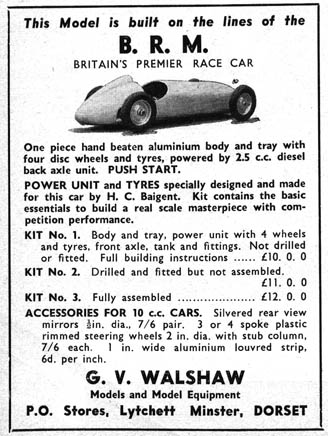
an advert of that time showing Walshaw's efforts at trading and using some of our parts:
At weekends and evenings I still helped Henri, in his workshop, but he was considerably depressed, and no wonder. In the following period he moved on to look at electric propulsion with the home consumer in mind as an alternative to model railways. He could only put part of his working day to this because he had to earn some money doing some small engineering contracts to keep the wolves away from the door. There was no help from the state in those days. I was livid at the time we were homeless over 50 years ago, surely, but time heals. Anyway, I have tried hard to live by the maxim, 'never bear any malice', for a start, it only really hurts oneself, but can cause much grief in a troubled world. Here is the evidence that I put before you in Alban's own words, and in print, that should be enough!
Firstly, here is an extract from D J Laidlaw-Dickson's book 'Model Rail Car Racing',
".....walls to separate each car each in a separate track of its own. This idea later proved to be the basis of an alternative method produced by Henri Baigent, who was the original patentee of the diesel rail track "zonkers" or guides popularised by Alban Adams through his firm Model Road Racing Cars Ltd, of Boscombe."
and in the same chapter: "Alban Adams, patentee of the larger type of track, started to manufacture electric rail racing outfits."
For years since then, Alban Adams and unsuspecting enthusiasts, have spread the 'myth' that he was the inventor of nearly everything from the initial concepts. He did not do so. Did Alexander Fleming invent Penicillin? No! it is a common mistake, it was Howard Florey and Ernst Chain at Oxford University, see here: http://www.chm.bris.ac.uk/webprojects2002/thornton/discovery_of_penicillin.htm. However, Fleming has been almost universally credited with it. Did John Logie Baird invent television? No, he has been credited with it, but history is really hazy about it! These men just took all the credit themselves, and the press reports were believed. These are facts that one can check if enough rigour is applied.
There is no date mentioned in the Laidlaw-Dickson excerpt. By 'larger', I guess, the author meant the diesel tracks, but this is an error perpetrated by many since. Alban Adams was not a patentee of the system of track-racing or rail-racing. He was not the patentee, it was Henri Baigent, as admitted in a letter from Alban Adams, in the press, see here.
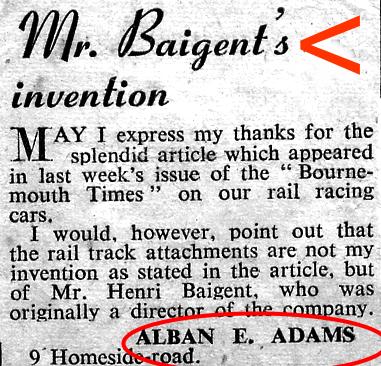
above, a letter to the Bournemouth Times from Alban Adams admitting that it was Henri Baigent that invented the rail-track attachments, and not himself, as claimed so many times
In my own long experience, one man can have an idea, but seldom has enough time or pace to see it through on his own. The great thinker and poet, John Donne, was so right when he wrote "...no man is an island...". Most good ideas need a team-led development process to be of any use, that requires more minds and hands. I myself have had ideas that have come out of the 'blue', perhaps best called inspirations. To be honest, they do not come from a rational thought process, nor with any relevance, but spontaneously and suddenly, with no connection to any other thought train. Often in a waking moment, almost ethereal. Sometimes they are practical, other times, completely irrational. Here come the men in white coats! Henri experienced these visions. Both of his brothers did so and I have experienced them. At least one of my sons does also. I have met others who have experienced it. Maybe it is a subconscious free-wheeling part of the brain which develops more in some people than others, especially if it is nurtured. I am inclined to think it is the child in us that is having its say. That is, the free-thinking creative part of ourselves, the child that we try to leave behind. Julia Cameron (Martin Skorses's ex-wife and friend of Steven Spielberg) has written in depth about this in her excellent book, 'The Artist's Way'. It is still in print, and eminently readable. She deals with writers' block, and depression, so well. I strongly recommend it. It helped me so much when I had problems of my own.
Henri did not have the funds or time to fight for his patent rights at that time, but I have the evidence from the European Patents Office that the UK version was ratified 24th December 1952 (GB684951. The US Patent Office issued a Patent No 2,642,815 on Jun 23rd 1953. It seems that MRRC Ltd tried to patent the ideas 20th November 1956, but I can find no patent issued. I think it must have been refused. Henry C Baigent was nominated as the inventor. Details of Henri's patents can be found here: http://v3.espacenet.com/results?sf=q&DB=EPODOC&IA=baigent&PGS=10&CY=ep&LG=en&ST=quick . The rest is history.
I haven't seen Alf Walshaw since, or spoken to Alban Adams, but during the late 1960s I bumped into Adams when I was at the Brighton Toy Fair where I found him on the Airfix stand. He was a representative selling plastic kits of planes and cars. I do not think he recognized me, and I did not speak to him as I did not want to embarrass him or my companions. It seems that Airfix took MRRC under their business umbrella, because in the 1960s they were advertising as Airfix MRRC from London SW18. I am sure others would know more about that history than myself as I had lost most of my interest in the model world by then. I had gone forward to work on the design of full-size engineering projects.
top left, a letter written to the Bournemouth Echo by my sister, Muriel, when she saw that they had credited Alban Adams with the invention of model car track racing, and hence Scalextrics. Top right is the cutting from the Bournemouth Echo that she refers to in her letter. Bottom left, the editor's reply from the Bournemouth Echo and, bottom right, the correction printed in the paper Sat October 18th 1986
For the record: I readily applaud Alban Adams for taking this potentially great hobby to fruition so that so many clubs, and even families, have been able to enjoy the racing. My own sons enjoyed their time with their Scalextric set. Personally, as I started out with and experienced Diesel Racing up to 2.5cc, I only really get thrilled by that type of model racing, or, perhaps I will try r/c racing with aircraft someday. If the opportunity arose, I might be inclined to set up a car racing track with diesel or glowplug drives in mind, but I think one would have to go through an unbelievable amount of red-tape with the Health and Safety Executive and planning authorities (in the UK anyway). I think it would still be a commercial success though, and I do have all the patents to hand! Maybe at a venue like Alton Towers or Blackpool? The showmen of Blackpool often approached Henri during the 1960s to create new show attractions, but he had to refuse. He was heavily contracted to build scratch models by then.
I have only written down here what I have been given to understand to be the truth, I hope that I have not caused offence or infringed any copyrights. If I have strayed, and you have evidence to uphold your case, I would be very grateful if you would write to me, or send me an email, so that the matter may be discussed. If I am found to be at fault, I will retract any wrong, and/or sort out any infringement. I am not to receive any personal gain for this work, but if anybody should want to donate to one of the charities listed within this site, I would indeed be pleased to pass on any donation in a proper way.
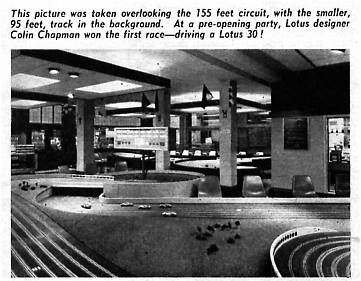
above, the hobby developed rapidly and some tracks were enormous.